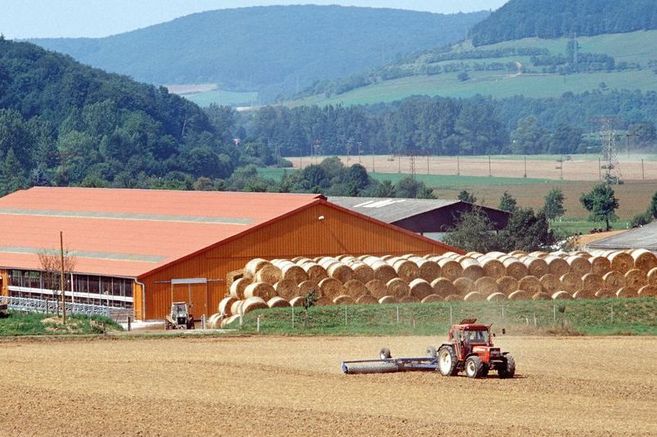Project
Ecological and Socioeconomic Functions of Tropical Lowland Rainforest Transformation Systems (EFForTS)

Collaborative Research Centre 990: Ecological and Socioeconomic Functions of Tropical Lowland Rainforest Transformation Systems (Sumatra, Indonesia)
The transformation of tropical rainforest to rubber and oil palm plantations has extensive impact on nature and living conditions. Remote sensing helps us to understand the spatial-temporal patterns and drivers of those processes.
Background and Objective
Over the last decades, the lowlands of Jambi province in Sumatra (Indonesia) have undergone a major transformation from forests towards a cash crop-dominated landscape of rubber and oil palm plantations. EFForTS is a Collaborative Research Centre 990 funded by the Deutsche Forschungsgemeinschaft (DFG, German Research Foundation) that investigates the ecological and socio-economic effects of such transformation based on research carried out in the Bukit Duabelas and Hutan Harapan area in Jambi province focusing on smallholder systems.
Approach
In the EFForTS project, more than 160 researchers from the University of Göttingen, University of Hohenheim, Thünen-Institute and Leibniz Association in Germany and the Indonesian universities IPB University (Bogor), UNTAD (Tadulako University, Palu) and UNJA (University of Jambi) work in close cooperation, representing a wide range of disciplines including ecology, forestry, agriculture, remote sensing, economics, human geography, and cultural anthropology.
Within this context, remote sensing supports the following tasks:
- documentation of land use and land cover change in the province of Jambi, Sumatra
- assessment of structural parameters in forests and plantations using metrics that are derived based on high resolution point clouds from an airborne laser scanning campaign
- scaling-up of state and pressure indicators in forest and plantation ecosystems from the plot to the landscape level based on all available remote sensing data
Results
As part of the tasks, a series of spatially-explicit information layers were generated for the project on the status and condition of land use and stock structure in the study area. For this purpose, new methods of data processing and evaluation were developed and scientifically published (see publications).
The list of products derived from remote sensing data includes in detail:
- a collection of 22 metrics of vegetation structure created from LIDAR aerial survey data for parts of the study area (see Camaretta et al. 2021)
- a land cover classification based on the LIDAR metrics for the reference year 2020 (see Camaretta et al. 2021)
- Maps of vegetation height (canopy height) for the entire study area (Jambi province) based on a fusion of point-based satellite LIDAR images (GEDI) and interferometric radar data from the TanDEM-X mission available over the entire study area (Schlund et al. 2023)
- Maps of aboveground biomass and its change (2012/2019) based on digital elevation models from the TanDEM-X mission that were corrected for SAR signal penetration (Schlund et al. 2021)
The available data and products serve the project partners as a basis for upscaling the results from the field surveys and investigations from the plot level to the landscape level.
Links and Downloads
official webpage at University of Göttingen: www.uni-goettingen.de/en/310995.html
Thünen-Contact

Involved external Thünen-Partners
- Georg-August-Universität Göttingen
(Göttingen, Deutschland)
Funding Body
-
Deutsche Forschungsgemeinschaft (DFG)
(national, öffentlich)
Duration
1.2020 - 12.2023
More Information
Project status:
finished
Publications to the project
- 0
Montoya-Sanchez V, Schweiger AK, Schlund M, Paterno GB, Erasmi S, Kreft H, Hölscher D, Brambach F, Irawan B, Sundawati L, Zemp DC (2025) Spectral characterization of plant diversity in a biodiversity-enriched oil palm plantation. Remote Sensing Ecol Conserv: Online First, Sep 2025, DOI:10.1002/rse2.70034
- 1
Wenzel A, Westphal C, Ballauff J, Berkelmann D, Brambach F, Buchori D, Camaretta N, Corre MD, Daniel R, Darras K, Erasmi S, Formaglio G, Hölscher D, Al-Amin Iddris N, Irawan B, Knohl A, Kotowska MM, Krashevska V, Kreft H, Mulyani Y, et al (2024) Balancing economic and ecological functions in smallholder and industrial oil palm plantations. PNAS 121(17):e2307220121, DOI:10.1073/pnas.2307220121
- 2
Paterno GB, Brambach F, Guerrero-Ramírez N, Zemp DC, Cantillo AF, Camarretta N, Moura CCM, Gailing O, Ballauff J, Polle A, Schlund M, Erasmi S, Iddris NA, Khokthong W, Sundawati L, Irawan B, Hölscher D, Kreft H (2024) Diverse and larger tree islands promote native tree diversity in oil palm landscapes. Science 386(6723):795-802, DOI:10.1126/science.ado1629
- 3
May PB, Schlund M, Armston J, Kotowska MM, Brambach F, Wenzel A, Erasmi S (2024) Mapping aboveground biomass in Indonesian lowland forests using GEDI and hierarchical models. Remote Sens Environ 313:114384, DOI:10.1016/j.rse.2024.114384
- 4
Schlund M, Wenzel A, Camarretta N, Stiegler C, Erasmi S (2023) Vegetation canopy height estimation in dynamic tropical landscapes with TanDEM-X supported by GEDI data. Methods Ecol Evol 14(7):1639-1656, DOI:10.1111/2041-210X.13933
- 5
Schlund M, Kotowska MM, Brambach F, Hein J, Wessel B, Camarretta N, Silalahi M, Surati Jaya IN, Erasmi S, Leuschner C, Kreft H (2021) Spaceborne height models reveal above ground biomass changes in tropical landscapes. Forest Ecol Manag 497:119497, DOI:10.1016/j.foreco.2021.119497
- 6
Camarretta N, Ehbrecht M, Seidel D, Wenzel A, Zuhdi M, Merk MS, Schlund M, Erasmi S, Knohl A (2021) Using airborne laser scanning to characterize land-use systems in a tropical landscape based on vegetation structural metrics. Remote Sensing 13:4794, DOI:10.3390/rs13234794








